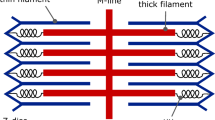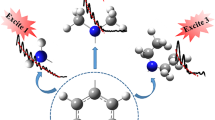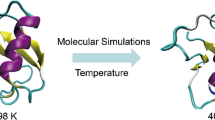Abstract
Actin is one of the important elements of the striated muscle that transmits force from the myosin filaments and as a part of the cytoskeleton plays an important role in shape determination of cells. It is a known experience that removal of the divalent cation affects the dynamic behaviour of actin in both forms. Paramagnetic probes and electron paramagnetic resonance (EPR) spectroscopy provide direct technique by which the rotation and the orientation of specifically labelled proteins can be followed during biochemical manipulations. The spectroscopic measurements could be combined with DSC measurements that report domain stability and interactions and allow the calculation of the thermodynamic parameters during the melting process. Actin was spin-labelled with maleimide or fluoro-dinitro proxyl probe molecules which are bound to the Cys-374 or Lys-61 residues of the smaller domain. EPR spectroscopy spectra were recorded in monomer form in Ca- and EGTA-state as a function of temperature up to the melting point. Similarly, DSC measurements were performed and analyzed using the kinetic theory. The measurements showed that removal of the divalent cation from the globular actin induced significant local and global structural change both in the thermodynamic properties and the rotational mobility of actin detected by DSC and EPR. On the basis of the results derived by deconvolution of the DSC pattern we can suggest a non-interactive two-domain melting for the monomer actin after removing the divalent cations.














Similar content being viewed by others
References
Chowdhury HH, Popoff MR, Zorec R. Actin cytoskeleton and exocytosis in rat melano-trophs. Pflugers Arch. 2000;439(3 Suppl):R148–9.
Cossart P. Bacterial actin based motility. Curr Opin Cell Biol. 1995;7:94–101.
Guillen N, Carlier MF, Brugerolle G, Tardieux I, Ausseil J. Cytoskeletal actin and its associated proteins. Some examples in Protista. Parasite. 1998;5:107–17.
Rice S, Lin AW, Safer D, Hart CL, Naber N, Carragher BO, Cain SM, Pechatnikova E, Wilson-Kubalek EM, Whittaker M, Pate E, Cooke R, Taylor EW, Milligan RA, Vale RD. A structural change in the kinesin motor protein that drives motility. Nature. 1999;402:778–84.
Lamaze C, Fujimoto LM, Yin HL, Schmid SL. The actin cytoskeleton is required for receptor-mediated endocytosis in mammalian cells. J Biol Chem. 1997;272:20332–5.
Marchand JB, Moreau P, Paoletti A, Cossart P, Carlier MF, Pantaloni D. Actin-based movement of Listeria monocytogenes: actin assembly results from the local maintenance of uncapped filament barbed ends at the bacterium surface. J Cell Biol. 1995;130:331–43.
Pollard TD. Missing link for intracellular bacterial motility? Curr Biol. 1995;5:837–40.
Lumry R, Eyring J. Conformation changes in proteins. J Phys Chem. 1954;58:110–34.
Sanchez-Ruiz JM, Lopez-Lacomba JL, Cortijo M, Mateo PL. Differential scanning calori-metry of the irreversible thermal denaturation of thermolysin. Biochemistry. 1988;27:1648–52.
Spudich JA, Watt S. The regulation of rabbit skeletal muscle contraction. I. Biochemical studies of the interaction of the tropomyosin-troponin complex with actin and the proteolytic fragments of myosin. J Biol Chem. 1971;246:4866–71.
Fajer PG, Marsh DJ. Microwave and modulation field inhomogenities and effect of cavity Q in saturation transfer EPR spectra. Dependence of sample size. J Magn Res. 1982;49:212–24.
Squier TC, Thomas DD. Methodology for increased precision in saturation transfer electron paramagnetic resonance studies of rotational dynamics. Biophys J. 1986;49:921–35.
Prochniewitz E, Walseth TF, Thomas DD. Structural dynamics of actin during active interaction with myosin: different effects of weakly and strongly bound myosin heads. Biochemistry. 2004;43:10642–52.
Oda T, Iwasa M, Aihara T, Maeda Y, Narita A. The nature of the globular-to fibrous–actin transition. Nature. 2009;457:441–5.
Acknowledgements
The SETARAM Micro DSC-II was purchased with a grant (CO-272) from the Hungarian Scientific Research Fund (Dénes Lőrinczy). ESP 300E EPR spectrometer was purchased with a grant (CO-123) from the Hungarian Scientific Research Fund (Joseph Belagyi).
Author information
Authors and Affiliations
Corresponding author
Rights and permissions
About this article
Cite this article
Könczöl, F., Belagyi, J. & Lőrinczy, D. Thermal and dynamic behaviour of the actin monomer in case of different cations. J Therm Anal Calorim 111, 1717–1723 (2013). https://doi.org/10.1007/s10973-012-2206-9
Received:
Accepted:
Published:
Issue Date:
DOI: https://doi.org/10.1007/s10973-012-2206-9




